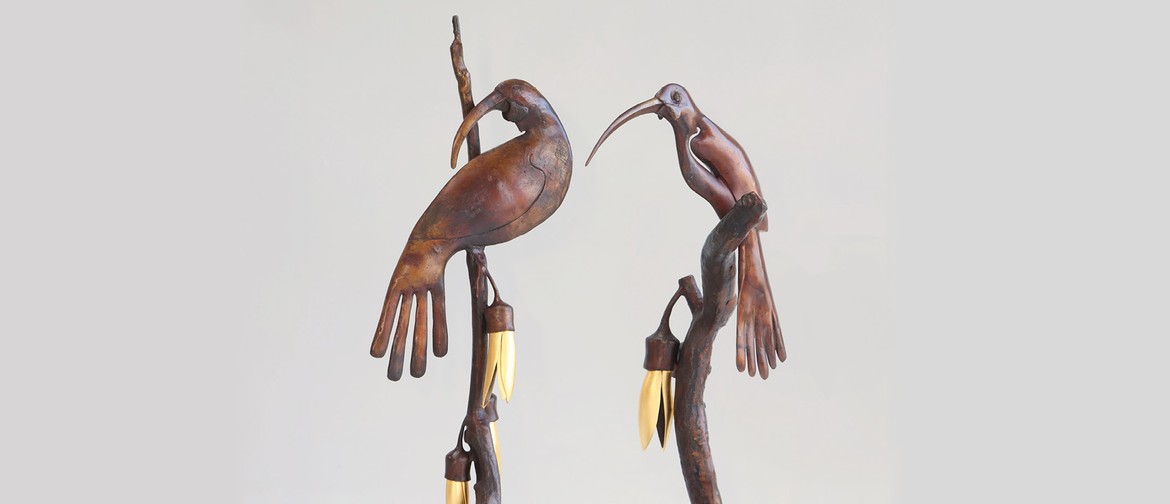Paul Dibble: Figures and Birds 2024

Ticket Information
Restrictions
Website
Listed by
Paul Dibble stands as the colossus at the epicentre of New Zealand sculpture. In his long and most distinguished career, he pioneered and delivered many very notable, distinctive and unforgettable works, but amongst his greatest achievements was that he built into these a singular New Zealand vernacular, an apropos visual language, acutely imbued with symbolism which could only be from here. In that manner his works came to express our collective values, concerns, beliefs, failings and losses, both human and animal.
Titled Figures and Birds, this major exhibition of works completed before his death in December has two primary groupings: there are three substantial geometric figure works and three associated models, and a larger grouping of works featuring native birds and kōwhai.
All of the figures are female and seem to be caught in moments of indecision or discomfort, discombobulation or inner discourse. We seem to be witnessing something private yet rivetingly sensuous in their apparent isolation. The differing articulations of each of the bodies adds further complexity, presence and emotional breadth, while separating each from the others, both in character and nuanced disposition. Conversations emerge about privacy, and with what we see and how we see it. A surprising plurality also arises: the incised nipples on the chest stare back as if another face is looking out and back. Their long arms hide and reveal.
Dibble’s career-long, confident use and adaptation of the geometric cone and ball, the role of line and flattened volume together builds these distinctive sensations: it’s as if the works have been drawn in space, right in front of us. He uses portions of circles, stretched rectangles, parallel lines, flat surfaces and squeezed space to short-cut and paraphrase the body and what we know to be there, and where.
And yet an understated dream-like elegance and compelling dignity pervades A Moment (2023), Waiting for Time to Pass (2023) and Listening to Stillness (2023). Can a viewer be both a voyeur and the object itself at the same time? In these three outstanding works, there is only one possible answer.
The emblematic blossoming golden yellow kōwhai is New Zealand’s unofficial national flower. It announces the end of winter, the arrival of spring, and is one of Paul Dibble’s most significant metaphorical symbols.
Culturally significant, Māori used its bark, leaves and juice for traditional rongoā (medicine), kōwhai flowers were the source of yellow dye, its dense wood used as a construction material in whare and snares for birds. The flowering of kōwhai also signalled time to plant kūmara. Semi-deciduous, commonly losing its leaves after flowering, all parts of the kōwhai, particularly the distinctive seedpods and seeds, are poisonous to humans.
Dibble uses the emphatic symbolism of exaggerated scale, its pendulous and suggestive divaricate petal form spreading from the clasp of its sepal cap, its stamen and ovaries hidden but openly implied in its spread-leg skirt-like presentation and fecundity. In this manner he builds multiple messages amidst dialogues of hope and belief.
Intermingled and inextricably linked with this is Dibble’s most forlorn and poignant symbol of loss: the Huia. Last sighted in the Tararuas, not far from Dibble’s workshop in Palmerston North, he has depicted huia in many guises and moods, hauntingly talking back to us from across time. It was systematically hunted to extinction because its unique beauty and feathers had it prized above all others by ornithologists such as Buller who supplied specimens to museums worldwide.
In Dibble’s work, the birds sit in judgement of who we think we are and our behaviours. Huia Sings Alone 1 (2023) and Huia Sings Alone 2 (2023) are at once both laments of loss and metaphors of love. Looking Back at the Lost Garden (2023) and Dialogue of Two Huia Model (2023) while compositionally very different, are equally exceptional examples of Dibble’s unity of purpose and underlying narrative conversations.
See Exhibition Page for Full Text
Log in / Sign up
Continuing confirms your acceptance of our terms of service.
Post a comment